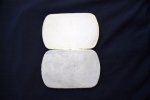This experiment below explains how white pool plaster can become blotchy gray, and also have white areas mixed into the gray areas.
Both white pool plaster coupons below have been in water for one year. Sometimes the water was slightly aggressive (negative CSI), and sometimes the water was slightly scale forming (positive CSI), but always within a good and proper range of -0.5 to +0.5 CSI. In other words, it follows a typical water chemistry balancing maintenance program of most residential pools for a one year period of time.
The top coupon was formed with only one percent calcium chloride (CC) added to the mix, and was properly troweled. It remained a “uniform white” the entire time.
The bottom coupon had 3% calcium chloride (CC) added, was late hard troweled, and also received some wet (water) troweling late in the process.

Note the light and darker color contrast of the bottom coupon creating a “blotchy” appearance. The darker areas are very dense due to the hard troweling. The lighter (white) areas and spots are due to higher water-to-cement ratio and porosity from wet troweling. Had that coupon not been troweled with water, it probably would have been more overall gray due to the high CC and late hard troweling only.
Sometimes, plasterers add 3% CC to a plaster mix to hurry up the hardening process and finish the pool faster. The plaster mix may harden so fast that the finishers can’t keep up. If the plaster is not smooth enough when the plaster becomes hard, the finishers may then splash water onto the surface to rework and soften up the plaster again in order to get it smooth.
This experiment by onBalance demonstrates that improper troweling and workmanship can create non-uniform discolorations of pool plaster, and the mechanics of discoloration and blotchiness can be the same with dark colored plaster.
Both white pool plaster coupons below have been in water for one year. Sometimes the water was slightly aggressive (negative CSI), and sometimes the water was slightly scale forming (positive CSI), but always within a good and proper range of -0.5 to +0.5 CSI. In other words, it follows a typical water chemistry balancing maintenance program of most residential pools for a one year period of time.
The top coupon was formed with only one percent calcium chloride (CC) added to the mix, and was properly troweled. It remained a “uniform white” the entire time.
The bottom coupon had 3% calcium chloride (CC) added, was late hard troweled, and also received some wet (water) troweling late in the process.

Note the light and darker color contrast of the bottom coupon creating a “blotchy” appearance. The darker areas are very dense due to the hard troweling. The lighter (white) areas and spots are due to higher water-to-cement ratio and porosity from wet troweling. Had that coupon not been troweled with water, it probably would have been more overall gray due to the high CC and late hard troweling only.
Sometimes, plasterers add 3% CC to a plaster mix to hurry up the hardening process and finish the pool faster. The plaster mix may harden so fast that the finishers can’t keep up. If the plaster is not smooth enough when the plaster becomes hard, the finishers may then splash water onto the surface to rework and soften up the plaster again in order to get it smooth.
This experiment by onBalance demonstrates that improper troweling and workmanship can create non-uniform discolorations of pool plaster, and the mechanics of discoloration and blotchiness can be the same with dark colored plaster.
Last edited:

